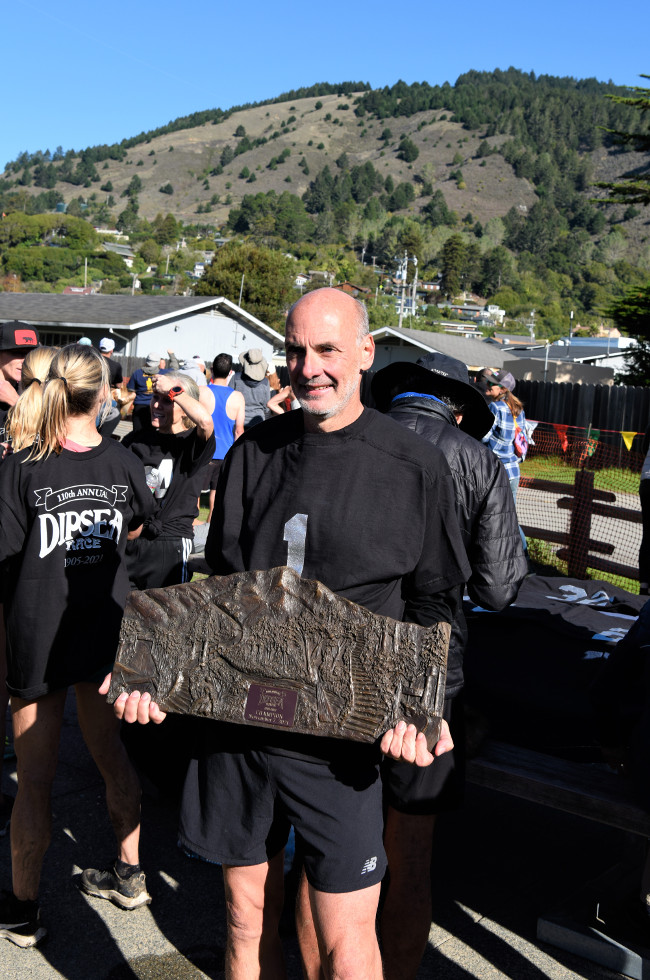Coloradoan Makes Mark As Dipsea Race Defending Champion

Mark Tatum near Cardiac with Sutro Tower in distance
Living in the shadow of Pikes Peak near Colorado Springs, Mark Tatum was more than a mile high after winning the 110th Dipsea last November.
Training at more than 6,000 feet above sea level in his hometown, Tatum combined his high altitude workouts with the experience he had gained since finishing seventh overall in his Dipsea debut in 2016 to become the first non-Californian to win the historic 7.5 mile trail race from Mill Valley to Stinson Beach since Gail Scott of Durango, Colorado in 1986 and the first male outside the state of California to win the historic trail race since Joe Patterson of Queensland, Australia in 1975 by finishing first the 110th Dipsea race.
It was a tough race for Tatum to win and even tougher one to relate to his friends back home.
“Part of the fun of competing at the Dipsea race is explaining it to others. It is complicated and makes for a great story. I have tried pretty hard to get others to enter, but without much success so far. That might change this year,” says Tatum, 62, a digital marketer who for the past two years has been training Amazon delivery drivers and delivering packages.
“Most people I have told about winning the Dipsea don’t really have a clear idea of what it means. Until you actually compete, or at least visit the finish line of a Dipsea race, it is difficult to understand how important it is to so many runners in the (Marin County area). Part of the local advantage is that focus on doing well at Dipsea. It was an honor to follow a great athlete like Gail Scott in that distinction. I did some research on her performances and she was a top-level competitor during that time. With more people traveling out of state to go to races, I think we will see some other non-Californians win in the coming years.”
In the 110th Dipsea, Tatum was followed to the finish line by Dan King of Boulder, CO, in his Dipsea debut. He was running as a tribute to his late father, Wilford, who twice posted the fastest time in the race; in 1955 when he placed second overall and 1957 when he finished in seventh place.
“This is the race I look forward to the most by far. The one I think about all year long,” says Tatum, a U.S. Mountain Run champion. “I love the history of this race and the incredible competition. That’s why I come.”
It was a friend and follow competitor, multiple Black Shirt winner Wes Thurman, who convinced Tatum to first try the Dipsea in 2016. He worked his way up to second place in 2019, finishing runner-up to four-time Dipsea champion Brian Pilcher. Tatum has come to appreciate the Dipsea to the point he boasted about it on a live podcast called “Ginger Post” and found a Dipsea fan in his coach, David Roche, who also hosts a podcast “Some Work, All Play.” In addition, Tatum recently organized a virtual trail race, Stephanie’s Challenge, in Colorado Springs and, to score it, utilized the Dipsea time handicapped system that awards head starts based on age and gender.
Tatum is obviously taken by the Dipsea and its quirks and traditions.
“It is meaningful to be part of something with a long history, which so many people care about,” he says. “I am appreciative of the other competitors who race hard each year. I am especially thankful for the volunteers who have managed to maintain the integrity of this unique race through many changes. Because we take this race seriously, it rewards us all, year after year, no matter how or where we finish.”
Tatum couldn’t have finished any higher the last time he raced the Dipsea. It was the first time since 1970 when the legendary Norman Bright, a Dipsea Hall of Famer from Seattle, was the last American male and non-Californian to be a Dipsea champion.
“The Dipsea was my focus race for a few years, and I think it takes that kind of single-mindedness to compete with all the others who also make it their `A’ race each year,’’ Tatum says. “It also fits my talents and abilities particularly well. It’s only an hour long and has steep climbs and long descents. I worked more on my aerobic base last year, and I think that ultimately helped me keep in touch with Dan and Brian on the long climb to the top of Cardiac and the run to Swoop. I believe altitude training mostly helps with races at altitude. I’ve had plenty of mediocre races at sea level. It is more my focus on training for steep ups and downs that has helped me do well there.”
Tatum says he usually trains in Ute Valley Park, a short distance from his house which is perched in the Foothills along the Front Range of the Rocky Mountains He also loves to run in Garden of the Gods and Cheyenne Canon and occasionally trains on portions of Barr Trail, a 13-mile trail that goes from Manitou Springs to the Pikes Peak summit, elevation 14,115 feet above sea level. Tatum has competed in the Pikes Peak Ascent eight times and run in the Pike Peak Marathon once.
“It is one of the highlights of each year because of the challenge, competition and history,” Tatum says. “Plus, that mountain looms over town and is one of the best parts of living here.”
Repeating as Dipsea champion in Marin County will be challenging as well. Tatum incurs a one minute “Dipsea Champion” penalty in each of the next three races. Because of various work obligations and injuries Tatum hasn’t been able to train as well or as consistently. He also admits to a “natural letdown” after winning the Dipsea for the first time last November.
That does not diminish his feat.
“Now I get introduced as a Dipsea winner,” Tatum says. “I feel like I accomplished a big goal and as Dan King told me, `Nobody can take that away.’ That’s a good feeling.”

Mark Tatum with his trophy after the race
The 111th Dipsea Race from Mill Valley to Stinson Beach is scheduled for Sunday, June 12, 2022.